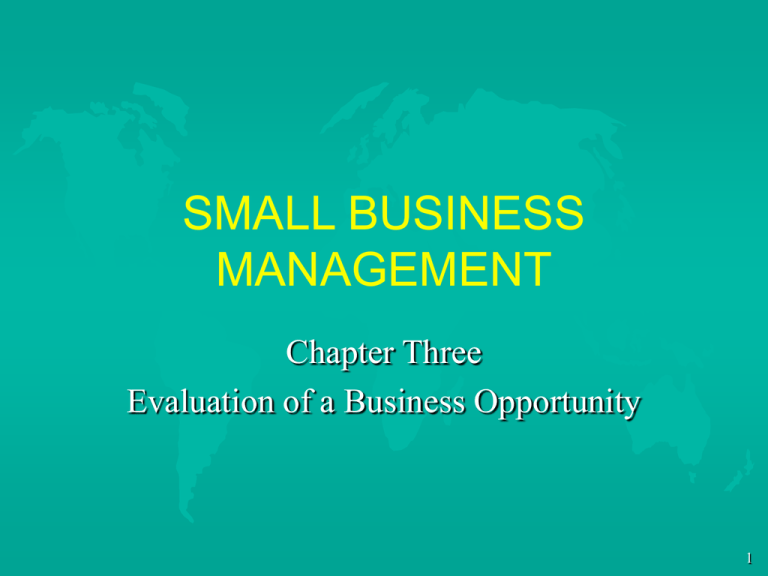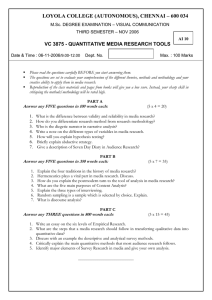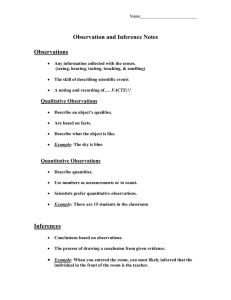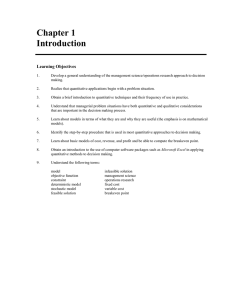SMALL BUSINESS MANAGEMENT Chapter Three Evaluation of a Business Opportunity
advertisement

SMALL BUSINESS MANAGEMENT Chapter Three Evaluation of a Business Opportunity 1 Non Quantitative Assessment of Business Opportunities Goals Content of Work Lifestyle Capabilities – Good health, management fundamentals, financial base Experience 2 Breaking Into The Market Three – – – ways offer a totally new product offer an existing product to a different market offer a product or service similar to those existing in the same market 3 Collection of Information Sources of Information Secondary data Primary data – – – observations experiments surveys Mail surveys, Telephone surveys, Personal interviews, Focus groups 4 Quantitative Assessment of Business Opportunities Preparing – – – the Feasibility Analysis Step One - Calculate the market Potential Step Two - Calculate the market Share Step Three - Calculate the Net Income and Cash Flow 5 Quantitative Assessment of Business Opportunities Step – – – One - calculate the Market Potential Determine the Market Area and its population Obtain revenue , sales statistics for type of product or service in the area Adjust the market potential as necessary 6 Quantitative Assessment of Business Opportunities Step Two - Calculate the Market Share Retail Firm – – – 1. Estimate the total amount of selling space in the market devoted to the new business will sell 2. Estimate the size of the proposed store 3. Calculate the market share based on selling space 7 Quantitative Assessment of Business Opportunities Step Two - Calculate the Market Share Retail Firm – – 4. Make adjustments to reflect any competitor strengths and weaknesses regarding the proposed store 5. Multiply the revised market share percentage by the market potential estimate obtained in Step One. 8 Quantitative Assessment of Business Opportunities Step Two - Calculate the Market Share Manufacturing Firm – – – 1. Estimate the total productive capacity in the market for the product to be manufactured 2. Estimate the total productive capacity of the proposed manufacturing plant. 3. Calculate the market share based on productive capacity 9 Quantitative Assessment of Business Opportunities Step Two - Calculate the Market Share Manufacturing Firm – – 4. Make adjustments to reflect competitive strengths and weaknesses the competitive plant may possess 5. Multiply the estimated market share percentage by the market share potential estimate obtained in Step One. 10 Quantitative Assessment of Business Opportunities Step Two - Calculate the Market Share Service Firm Step Two - Calculate the Market Share – – – Retail Firm 1. Estimate the total capacity of the se4rvice available in the market area 2. Estimate the service capacity of the proposed business 3. Calculate the market share based on the capacity base 11 Quantitative Assessment of Business Opportunities Step Two - Calculate the Market Share Service Firm 4. Make adjustments similar to those made for a retail store – 5. Multiply the revised market share percentage by the market potential estimated in step 1. – 12 Quantitative Assessment of Business Opportunities Step Three - Calculate net income and cash flow – 1. Using the market share from Step Two, calculate the expenses expected cost of goods sold and gross profit percentages; cash operating expenses; interest and depreciation – 2. Subtract expenses from revenue to determine projected net income in the first year and subsequent years. 13 Self Assessment for a Small Business Opportunity Personality Nature Abilities Experience Financial base Feasibility 14 Concept Checks 1. What non quantitative factors should be considered in the selection of a small business? 2. What are three ways of entering the market? 3. What are two methods of collecting information? In what situations would they be most useful? 15 Concept Checks 4. What are the three methods of collecting primary data? Which is the most relevant to a small business? 5. What steps are involved in determining the financial feasibility of a retail store? 16


